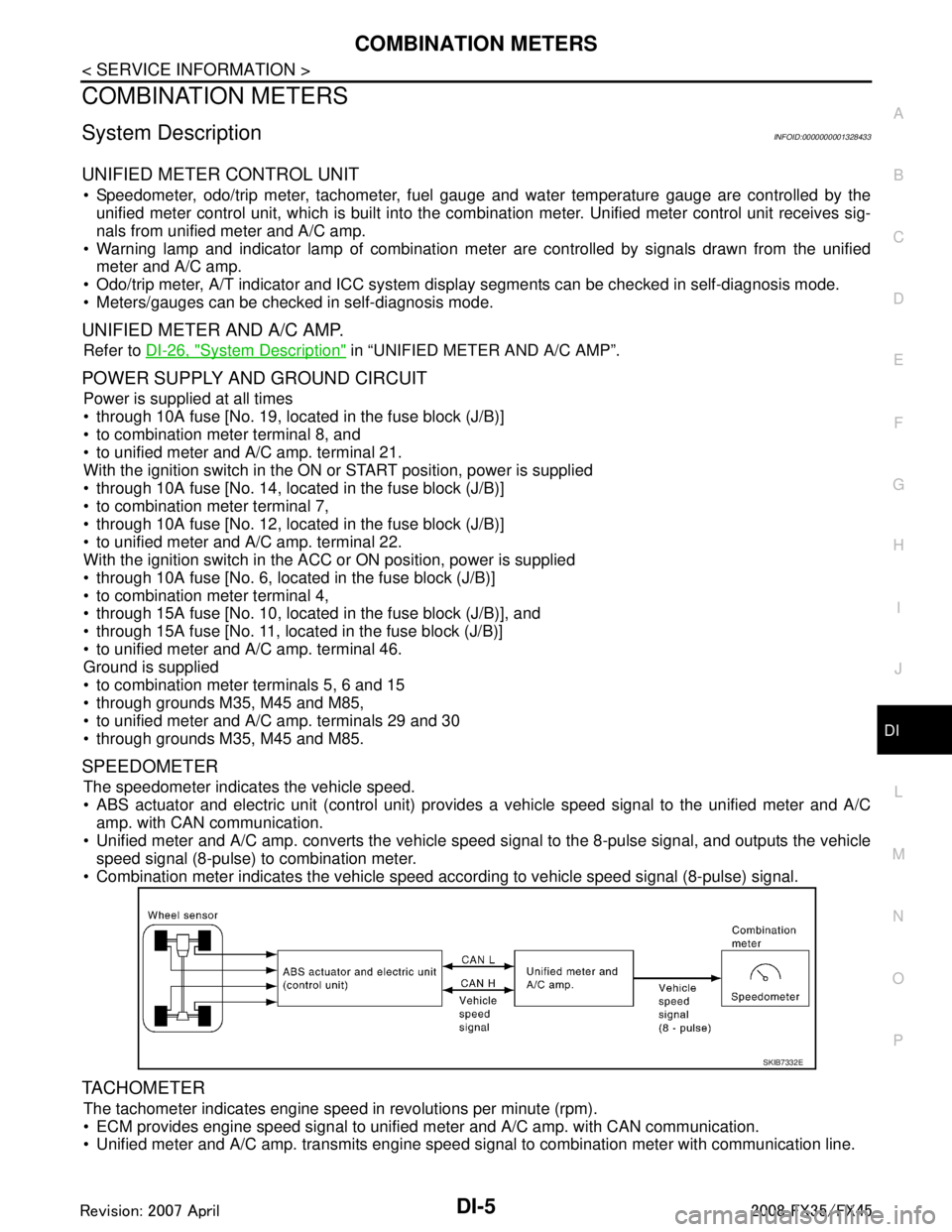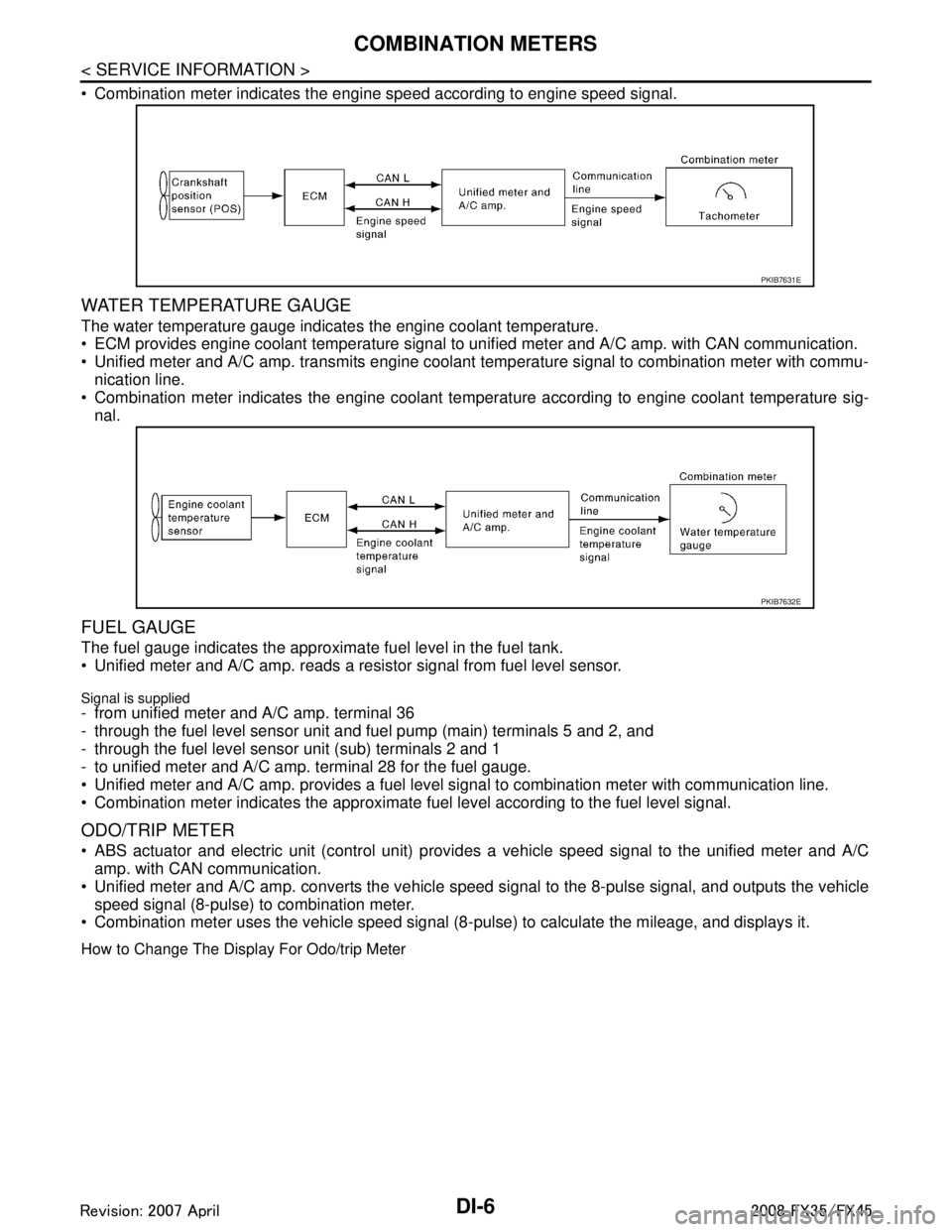2008 INFINITI FX35 engine
[x] Cancel search: enginePage 1121 of 3924
![INFINITI FX35 2008 Service Manual
CO-50
< SERVICE INFORMATION >[VK45DE]
WATER PUMP
WATER PUMP
ComponentINFOID:0000000001325882
Removal and InstallationINFOID:0000000001325883
CAUTION:
When removing water pump, be careful no
t to ge INFINITI FX35 2008 Service Manual
CO-50
< SERVICE INFORMATION >[VK45DE]
WATER PUMP
WATER PUMP
ComponentINFOID:0000000001325882
Removal and InstallationINFOID:0000000001325883
CAUTION:
When removing water pump, be careful no
t to ge](/manual-img/42/57017/w960_57017-1120.png)
CO-50
< SERVICE INFORMATION >[VK45DE]
WATER PUMP
WATER PUMP
ComponentINFOID:0000000001325882
Removal and InstallationINFOID:0000000001325883
CAUTION:
When removing water pump, be careful no
t to get engine coolant on drive belts.
Water pump can not be disassembled and should be replaced as a unit.
After installing water pump, connect hose and clamp securely, then check for leaks using radiator
cap tester (commercial service tool) and radiator cap tester adapter (commercial service tool).
REMOVAL
1. Drain engine coolant from drain plugs on radiator and both side of cylinder block. Refer to CO-37, "Chang-
ing Engine Coolant" and EM-242, "Disassembly and Assembly".
CAUTION:
Perform this step when engine is cold.
Do not spill engine coolant on drive belts.
2. Remove following parts: Engine front undercover
Air duct (inlet): Refer to EM-173, "
Component".
Alternator, water pump and A/C compressor belt: Refer to EM-170, "
Component".
3. Remove fan coupling with cooling fan, and then fan and water pump pulley.
4. Remove water pump. Engine coolant will leak from cylinder block, so have a receptacle ready under vehicle.
CAUTION:
Handle the water pump vane so that it does not contact any other parts.
Do not disassemble water pump.
INSPECTION AFTER REMOVAL
1. Fan and water pump pulley 2. Water pump 3. Gasket
PBIC1538E
3AA93ABC3ACD3AC03ACA3AC03AC63AC53A913A773A893A873A873A8E3A773A983AC73AC93AC03AC3
3A893A873A873A8F3A773A9D3AAF3A8A3A8C3A863A9D3AAF3A8B3A8C
Page 1122 of 3924
![INFINITI FX35 2008 Service Manual
WATER PUMPCO-51
< SERVICE INFORMATION > [VK45DE]
C
D
E
F
G H
I
J
K L
M A
CO
NP
O
Visually check that there is no significant dirt or rusting on water
pump body and vane.
Make sure there is no loo INFINITI FX35 2008 Service Manual
WATER PUMPCO-51
< SERVICE INFORMATION > [VK45DE]
C
D
E
F
G H
I
J
K L
M A
CO
NP
O
Visually check that there is no significant dirt or rusting on water
pump body and vane.
Make sure there is no loo](/manual-img/42/57017/w960_57017-1121.png)
WATER PUMPCO-51
< SERVICE INFORMATION > [VK45DE]
C
D
E
F
G H
I
J
K L
M A
CO
NP
O
Visually check that there is no significant dirt or rusting on water
pump body and vane.
Make sure there is no looseness in vane shaft, and that it turns
smoothly when rotated by hand.
If anything is found, replace water pump.
INSTALLATION
Install in the reverse order of removal.
INSPECTION AFTER INSTALLATION
Check for leaks of engine coolant using radiator cap tester adapter (commercial service tool) and radiator
cap tester (commercial service tool). Refer to CO-37, "
Inspection".
Start and warm up engine. Visually check if there is no leaks of engine coolant.
PBIC1539E
3AA93ABC3ACD3AC03ACA3AC03AC63AC53A913A773A893A873A873A8E3A773A983AC73AC93AC03AC3
3A893A873A873A8F3A773A9D3AAF3A8A3A8C3A863A9D3AAF3A8B3A8C
Page 1124 of 3924
![INFINITI FX35 2008 Service Manual
THERMOSTAT AND WATER CONTROL VALVECO-53
< SERVICE INFORMATION > [VK45DE]
C
D
E
F
G H
I
J
K L
M A
CO
NP
O
Refer to
GI-8, "Component" for symbols in the figure.
Removal and InstallationINFOID:000000 INFINITI FX35 2008 Service Manual
THERMOSTAT AND WATER CONTROL VALVECO-53
< SERVICE INFORMATION > [VK45DE]
C
D
E
F
G H
I
J
K L
M A
CO
NP
O
Refer to
GI-8, "Component" for symbols in the figure.
Removal and InstallationINFOID:000000](/manual-img/42/57017/w960_57017-1123.png)
THERMOSTAT AND WATER CONTROL VALVECO-53
< SERVICE INFORMATION > [VK45DE]
C
D
E
F
G H
I
J
K L
M A
CO
NP
O
Refer to
GI-8, "Component" for symbols in the figure.
Removal and InstallationINFOID:0000000001325885
REMOVAL
1. Drain engine coolant from drain plugs on radiat or and both side of cylinder block. Refer to CO-37, "Chang-
ing Engine Coolant" and EM-242, "Disassembly and Assembly".
CAUTION:
Perform this step when engine is cold.
Do not spill engine coolant on drive belts.
2. Remove engine cover with power tool. Refer to EM-169, "
Component".
3. Remove air duct (inlet). Refer to EM-173, "
Component".
4. Disconnect water suction hose from water inlet.
5. Remove water inlet and thermostat. CAUTION:
Do not disassemble thermostat.
6. Remove intake manifolds (upper and lower). Refer to EM-175, "
Component".
7. Disconnect radiator hose (upper) and wa ter hoses from thermostat housing.
8. Disconnect heater hoses from water outlet and heater pipe.
9. Remove thermostat housing, water outlet pipe, water connector, water control valve, water outlet and heater pipe.
CAUTION:
Do not disassemble water control valve.
INSPECTION AFTER REMOVAL
Make sure that valves both in thermostat and water c ontrol valve are completely closing at normal tempera-
ture.
Place a thread so that it is caught in the valves of the thermostat
and water control valve. Immerse fully in a container filled with
water. Heat while stirring. (The example in the figure shows ther-
mostat.)
The valve opening temperature is the temperature at which the valve opens and falls from the thread.
Continue heating. Check the maximum valve lift. NOTE:
The maximum valve lift standard temperature for water control
valve is the reference value.
After checking the maximum valve lift, lower the water tempera-
ture and check the valve closing temperature.
Standard values:
If the malfunctioning condition, when closing valve at nor mal temperature, or measured values are out of the
standard, replace thermostat and/or water control valve.
INSTALLATION
Note the following, and install in the reverse order of removal.
CAUTION:
Be careful not to spill engine coolant over en gine room. Use rag to absorb engine coolant.
Thermostat and Water Control Valve
D. To heater core E. To cylinder head (left bank) F. To cylinder head (right bank)
G. To intake manifold adapter
SLC252B
Thermostat Water control valve
Valve opening temperature 80 - 84 °C (176 - 183 °F) 93.5 - 96.5 °C (200 - 206 °F)
Maximum valve lift More than 10 mm/95
°C
(0.39 in/203 °F) More than 8 mm/108
°C
(0.315 in/226 °F)
Valve closing temperature 77 °C (171 °F) 90 °C (194 °F)
3AA93ABC3ACD3AC03ACA3AC03AC63AC53A913A773A893A873A873A8E3A773A983AC73AC93AC03AC3
3A893A873A873A8F3A773A9D3AAF3A8A3A8C3A863A9D3AAF3A8B3A8C
Page 1125 of 3924
![INFINITI FX35 2008 Service Manual
CO-54
< SERVICE INFORMATION >[VK45DE]
THERMOSTAT AND WATER CONTROL VALVE
Install thermostat and water control valve with the whole circumfer-
ence of each flange part fit securely inside rubber rin INFINITI FX35 2008 Service Manual
CO-54
< SERVICE INFORMATION >[VK45DE]
THERMOSTAT AND WATER CONTROL VALVE
Install thermostat and water control valve with the whole circumfer-
ence of each flange part fit securely inside rubber rin](/manual-img/42/57017/w960_57017-1124.png)
CO-54
< SERVICE INFORMATION >[VK45DE]
THERMOSTAT AND WATER CONTROL VALVE
Install thermostat and water control valve with the whole circumfer-
ence of each flange part fit securely inside rubber ring. (The exam-
ple in the figure shows thermostat.)
Install thermostat with jiggle valve facing upwards. (The position deviation may be within the range of ±10 degrees)
Install water control valve with the up-mark facing up and the frame
center part facing upwards. (The position deviation may be within
the range of ±10 degrees)
Water Outlet Pipe and Heater Pipe
First apply a neutral detergent to O-rings, then quickly insert the insertion parts of the water outlet pipe and
heater pipe into the installation holes.
INSPECTION AFTER INSTALLATION
Check for leaks of engine coolant using radiator cap tester adapter (commercial service tool) and radiator
cap tester (commercial service tool). Refer to CO-37, "
Inspection".
Start and warm up engine. Visually check if there is no leaks of engine coolant.
PBIC0157E
PBIC0158E
3AA93ABC3ACD3AC03ACA3AC03AC63AC53A913A773A893A873A873A8E3A773A983AC73AC93AC03AC3
3A893A873A873A8F3A773A9D3AAF3A8A3A8C3A863A9D3AAF3A8B3A8C
Page 1126 of 3924
![INFINITI FX35 2008 Service Manual
SERVICE DATA AND SPECIFICATIONS (SDS)
CO-55
< SERVICE INFORMATION > [VK45DE]
C
D
E
F
G H
I
J
K L
M A
CO
NP
O
SERVICE DATA AND SPECIFICATIONS (SDS)
Standard and LimitINFOID:0000000001325886
ENGINE COO INFINITI FX35 2008 Service Manual
SERVICE DATA AND SPECIFICATIONS (SDS)
CO-55
< SERVICE INFORMATION > [VK45DE]
C
D
E
F
G H
I
J
K L
M A
CO
NP
O
SERVICE DATA AND SPECIFICATIONS (SDS)
Standard and LimitINFOID:0000000001325886
ENGINE COO](/manual-img/42/57017/w960_57017-1125.png)
SERVICE DATA AND SPECIFICATIONS (SDS)
CO-55
< SERVICE INFORMATION > [VK45DE]
C
D
E
F
G H
I
J
K L
M A
CO
NP
O
SERVICE DATA AND SPECIFICATIONS (SDS)
Standard and LimitINFOID:0000000001325886
ENGINE COOLANT CAPACITY (APPROXIMATE)
Unit: (US qt, Imp qt)
RADIATOR
Unit: kPa (kg/cm2, psi)
THERMOSTAT
WATER CONTROL VALVE
Engine coolant capacity [With reservoir tank at (“MAX” level)] 10.0 (10-5/8, 8-3/4)
Reservoir tank engine coolant capacity (at “MAX” level) 0.8 (7/8, 3/4)
Radiator cap relief pressure
Standard 78 - 98 (0.8 - 1.0, 11 - 14)
Limit 59 (0.6, 9)
Leakage testing pressure 157 (1.6, 23)
Valve opening temperature 80 - 84 °C (176 - 183 °F)
Maximum valve lift More than 10 mm/95 °C (0.39 in/203 °F)
Valve closing temperature 77 °C (171 °F)
Valve opening temperature 93.5 - 96.5 °C (200 - 206 °F)
Maximum valve lift More than 8 mm/108 °C (0.315 in/226 °F)
Valve closing temperature 90 °C (194 °F)
3AA93ABC3ACD3AC03ACA3AC03AC63AC53A913A773A893A873A873A8E3A773A983AC73AC93AC03AC3
3A893A873A873A8F3A773A9D3AAF3A8A3A8C3A863A9D3AAF3A8B3A8C
Page 1127 of 3924

DI-1
ELECTRICAL
C
DE
F
G H
I
J
L
M
SECTION DI
A
B
DI
N
O P
CONTENTS
DRIVER INFORMATION SYSTEM
SERVICE INFORMATION .. ..........................3
DTC INDEX ..................................................... .....3
U1000 - U1010 .................................................... ......3
B2202 - B2205 ..........................................................3
C1B00 - C1B03 .........................................................3
PRECAUTION .....................................................4
Precaution for Supplemental Restraint System
(SRS) "AIR BAG" and "SEAT BELT PRE-TEN-
SIONER" ............................................................. ......
4
COMBINATION METERS ...................................5
System Description ............................................. ......5
Component Parts and Harness Connector Loca-
tion ............................................................................
8
Arrangement of Combination Meter ..........................9
Circuit Diagram .......................................................10
Wiring Diagram - METER - .....................................11
Terminal and Reference Value for Combination
Meter .......................................................................
13
Terminal and Reference Value for Unified Meter
and A/C Amp ...........................................................
14
Self-Diagnosis Mode of Combination Meter ............14
CONSULT-III Function (METER/M&A) ...................15
Trouble Diagnosis ...................................................15
Symptom Chart .......................................................16
Power Supply and Ground Circuit Inspection .........16
Vehicle Speed Signal Inspection .............................17
Engine Speed Signal Inspection .............................18
Engine Coolant Temperature Signal Inspection ......19
Fuel Level Sensor Signal Inspection .......................19
Fuel Gauge Pointer Fluctuates, Indicator Wrong
Value or Varies ........................................................
21
Fuel Gauge Does Not Move to FULL Position ........21
Odo/Trip Meter and Illumination Control Switch In-
spection ............................................................... ....
21
Electrical Component Inspection .............................21
Removal and Installation of Combination Meter .....22
Disassembly and Assembly of Combination Meter
....
23
Removal and Installation of Odo/Trip Meter and Il-
lumination Control Switch .................................... ....
24
UNIFIED METER AND A/C AMP ......................26
System Description ..................................................26
Schematic ................................................................27
CONSULT-III Function (METER/M&A) ....................27
Power Supply and Ground Circuit Inspection ..........29
DTC [U1000] CAN Communication Circuit ..............30
DTC [B2202] Meter Commun ication Circuit ............30
DTC [B2205] Vehicle Speed Circuit .................... ....32
Removal and Installation of Unified Meter and A/C
Amp .........................................................................
32
WARNING LAMPS ............................................34
System Description .............................................. ....34
Schematic ................................................................35
Wiring Diagram - WARN - .......................................36
Oil Pressure Warning Lamp Stays Off (Ignition
Switch ON) .......................................................... ....
43
Oil Pressure Warning Lamp Does Not Turn Off
(Oil Pressure Is Normal) ...................................... ....
45
Component Inspection .............................................46
A/T INDICATOR ................................................47
System Description ..................................................47
Wiring Diagram - AT/IND - .......................................48
A/T Indicator Is Malfunction .....................................49
WARNING CHIME .............................................51
System Description .............................................. ....51
Component Parts and Harness Connector Loca-
tion ...........................................................................
53
Schematic ................................................................54
Wiring Diagram - CHIME - .......................................55
Terminal and Reference Value for BCM ..................57
Terminal and Reference Value for Unified Meter
and A/C Amp. ...................................................... ....
59
Terminal and Reference Value for Combination
Meter .......................................................................
59
CONSULT-III Function (METER/M&A) ....................60
3AA93ABC3ACD3AC03ACA3AC03AC63AC53A913A773A893A873A873A8E3A773A983AC73AC93AC03AC3
3A893A873A873A8F3A773A9D3AAF3A8A3A8C3A863A9D3AAF3A8B3A8C
Page 1131 of 3924

COMBINATION METERSDI-5
< SERVICE INFORMATION >
C
DE
F
G H
I
J
L
M A
B
DI
N
O P
COMBINATION METERS
System DescriptionINFOID:0000000001328433
UNIFIED METER CONTROL UNIT
Speedometer, odo/trip meter, tachometer, fuel gauge and water temperature gauge are controlled by the
unified meter control unit, which is built into the comb ination meter. Unified meter control unit receives sig-
nals from unified meter and A/C amp.
Warning lamp and indicator lamp of combination meter are controlled by signals drawn from the unified meter and A/C amp.
Odo/trip meter, A/T indicator and ICC system disp lay segments can be checked in self-diagnosis mode.
Meters/gauges can be checked in self-diagnosis mode.
UNIFIED METER AND A/C AMP.
Refer to DI-26, "System Description" in “UNIFIED METER AND A/C AMP”.
POWER SUPPLY AND GROUND CIRCUIT
Power is supplied at all times
through 10A fuse [No. 19, located in the fuse block (J/B)]
to combination meter terminal 8, and
to unified meter and A/C amp. terminal 21.
With the ignition switch in the ON or START position, power is supplied
through 10A fuse [No. 14, located in the fuse block (J/B)]
to combination meter terminal 7,
through 10A fuse [No. 12, located in the fuse block (J/B)]
to unified meter and A/C amp. terminal 22.
With the ignition switch in the ACC or ON position, power is supplied
through 10A fuse [No. 6, located in the fuse block (J/B)]
to combination meter terminal 4,
through 15A fuse [No. 10, located in the fuse block (J/B)], and
through 15A fuse [No. 11, located in the fuse block (J/B)]
to unified meter and A/C amp. terminal 46.
Ground is supplied
to combination meter terminals 5, 6 and 15
through grounds M35, M45 and M85,
to unified meter and A/C amp. terminals 29 and 30
through grounds M35, M45 and M85.
SPEEDOMETER
The speedometer indicates the vehicle speed.
ABS actuator and electric unit (control unit) provides a vehicle speed signal to the unified meter and A/C amp. with CAN communication.
Unified meter and A/C amp. converts the vehicle s peed signal to the 8-pulse signal, and outputs the vehicle
speed signal (8-pulse) to combination meter.
Combination meter indicates the vehicle speed according to vehicle speed signal (8-pulse) signal.
TACHOMETER
The tachometer indicates engine speed in revolutions per minute (rpm).
ECM provides engine speed signal to unified meter and A/C amp. with CAN communication.
Unified meter and A/C amp. transmits engine speed signal to combination meter with communication line.
SKIB7332E
3AA93ABC3ACD3AC03ACA3AC03AC63AC53A913A773A893A873A873A8E3A773A983AC73AC93AC03AC3
3A893A873A873A8F3A773A9D3AAF3A8A3A8C3A863A9D3AAF3A8B3A8C
Page 1132 of 3924

DI-6
< SERVICE INFORMATION >
COMBINATION METERS
Combination meter indicates the engine speed according to engine speed signal.
WATER TEMPERATURE GAUGE
The water temperature gauge indicates the engine coolant temperature.
ECM provides engine coolant temperature signal to unified meter and A/C amp. with CAN communication.
Unified meter and A/C amp. transmits engine coolant temperature signal to combination meter with commu-
nication line.
Combination meter indicates the engine coolant temper ature according to engine coolant temperature sig-
nal.
FUEL GAUGE
The fuel gauge indicates the approximate fuel level in the fuel tank.
Unified meter and A/C amp. reads a resistor signal from fuel level sensor.
Signal is supplied- from unified meter and A/C amp. terminal 36
- through the fuel level sensor unit and fuel pump (main) terminals 5 and 2, and
- through the fuel level sensor unit (sub) terminals 2 and 1
- to unified meter and A/C amp. terminal 28 for the fuel gauge.
Unified meter and A/C amp. provides a fuel level signal to combination meter with communication line.
Combination meter indicates the approximate fuel level according to the fuel level signal.
ODO/TRIP METER
ABS actuator and electric unit (control unit) provi des a vehicle speed signal to the unified meter and A/C
amp. with CAN communication.
Unified meter and A/C amp. converts the vehicle s peed signal to the 8-pulse signal, and outputs the vehicle
speed signal (8-pulse) to combination meter.
Combination meter uses the vehicle speed signal (8- pulse) to calculate the mileage, and displays it.
How to Change The Display For Odo/trip Meter
PKIB7631E
PKIB7632E
3AA93ABC3ACD3AC03ACA3AC03AC63AC53A913A773A893A873A873A8E3A773A983AC73AC93AC03AC3
3A893A873A873A8F3A773A9D3AAF3A8A3A8C3A863A9D3AAF3A8B3A8C